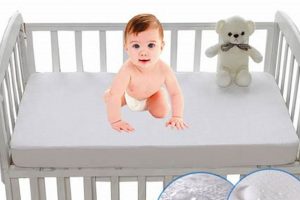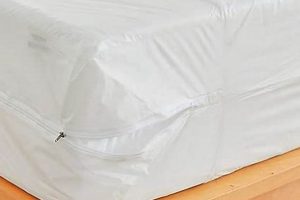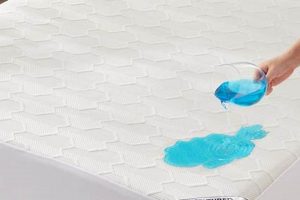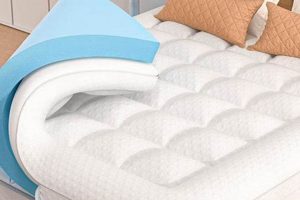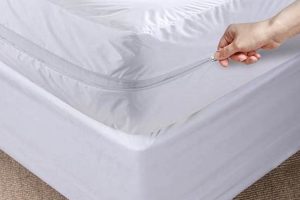The frequency with which a mattress protector requires laundering is a significant aspect of maintaining a clean and hygienic sleep environment. This determination hinges on several factors, including usage patterns, material composition, and the presence of potential contaminants like spills or allergens. A general guideline suggests a regular cleaning schedule to preserve its protective qualities and extend the lifespan of the mattress itself.
Consistent maintenance of this bedding component is vital for several reasons. It acts as a barrier against dust mites, body fluids, and other unwanted substances, thereby promoting better air quality within the sleeping space and potentially alleviating allergy symptoms. Regular washing also prevents the buildup of odors and stains, which contributes to a more comfortable and aesthetically pleasing bedroom. Over time, neglecting this aspect of bedding hygiene can lead to a reduction in its effectiveness as a protector and a degradation of its overall condition.
Considering the benefits of a well-maintained barrier, the subsequent sections will delve into specific recommendations for establishing a proper laundering routine, taking into account varying materials, potential issues, and strategies for effective cleaning. This will ensure that the protector continues to perform its intended function optimally.
Guidance on Protector Laundering Frequency
The following recommendations address the optimization of a mattress protector’s cleanliness and longevity through the implementation of appropriate washing protocols.
Tip 1: Establish a baseline cleaning schedule. For general use, laundering every one to two months is recommended to remove accumulated dust, skin cells, and other allergens.
Tip 2: Increase frequency in specific circumstances. If pets share the bed or individuals experience night sweats, consider washing every two weeks to maintain optimal hygiene.
Tip 3: Always address spills immediately. Promptly cleaning any spills or stains will prevent permanent damage and inhibit bacterial growth.
Tip 4: Adhere to manufacturer’s instructions. Always refer to the care label on the protector for specific washing and drying instructions to avoid damaging the material.
Tip 5: Select appropriate washing settings. Use a gentle cycle with cold or lukewarm water to preserve the fabric’s integrity and prevent shrinkage.
Tip 6: Use a mild detergent. Harsh chemicals can degrade the protective layer; opt for a hypoallergenic detergent to minimize potential irritation and damage.
Tip 7: Ensure thorough drying. Properly drying the protector after washing is crucial to prevent mold and mildew growth; air drying or using a low heat setting in the dryer is advisable.
Implementing these guidelines ensures the continued efficacy of the mattress protector, contributing to a healthier and more comfortable sleep environment.
The subsequent section will conclude this discussion with a summary of best practices and final recommendations.
1. Monthly (general use)
The recommendation for monthly washing of a mattress protector under general use conditions represents a balance between maintaining adequate hygiene and minimizing wear and tear on the fabric. This timeframe acknowledges the typical accumulation of dust mites, dead skin cells, and body oils that occur during routine sleep patterns.
- Standard Hygiene Maintenance
A monthly cleaning schedule effectively removes common allergens and contaminants that accumulate over a 30-day period. This frequency prevents the buildup of these substances to levels that could trigger allergic reactions or compromise the cleanliness of the sleeping environment. It is a preventive measure against the gradual degradation of the protector’s functionality due to accumulated debris.
- Material Durability Consideration
Frequent washing, while beneficial for hygiene, can potentially shorten the lifespan of the protector material. A monthly schedule strikes a balance, ensuring cleanliness without subjecting the fabric to excessive stress from repeated wash cycles. This is particularly relevant for protectors made of delicate or specialized materials, where more frequent washing could lead to premature wear or damage.
- Typical Usage Scenario
The monthly recommendation assumes a standard sleep environment, characterized by average humidity levels, no pets sharing the bed, and no instances of spills or accidents. If any of these factors are present, the washing frequency should be adjusted accordingly. For example, a bed shared with pets would necessitate more frequent cleaning to address pet dander and potential allergens.
- Cost-Effectiveness
From a practical standpoint, a monthly washing schedule aligns with typical laundry routines and avoids excessive water and energy consumption. It represents a reasonable commitment of time and resources while still providing a tangible benefit in terms of mattress protection and hygiene. Adjustments to this schedule should be based on specific needs and circumstances.
In summary, the “Monthly (general use)” guideline for mattress protector washing offers a pragmatic approach to maintaining a clean and healthy sleep environment. It balances the need for hygiene with considerations of material durability, usage patterns, and cost-effectiveness. Individual circumstances may warrant adjustments to this baseline recommendation.
2. Bi-weekly (allergy sufferers)
The recommendation for bi-weekly laundering of mattress protectors specifically targets individuals with allergies. This increased frequency is predicated on the heightened sensitivity of these individuals to common household allergens and the importance of minimizing exposure within the sleep environment. The rationale for this schedule stems from the rapid accumulation of allergens within bedding and the consequential impact on respiratory health and overall well-being.
- Elevated Allergen Load
Allergy sufferers are more acutely affected by allergens such as dust mites, pet dander, and pollen. These substances readily accumulate within bedding, including mattress protectors. A bi-weekly washing schedule mitigates the buildup of these allergens, reducing the likelihood of triggering allergic reactions and improving sleep quality. The protector acts as a critical barrier, but its effectiveness diminishes with saturation.
- Dust Mite Proliferation Control
Dust mites are a primary trigger for many allergy sufferers. These microscopic organisms thrive in bedding, feeding on dead skin cells. Regular laundering, particularly at higher temperatures, is an effective means of controlling dust mite populations. A bi-weekly schedule disrupts the mite life cycle and prevents them from reaching levels that exacerbate allergy symptoms. The protector, when clean, contributes to a less hospitable environment for these pests.
- Enhanced Respiratory Health
Exposure to allergens during sleep can lead to respiratory distress, including coughing, wheezing, and nasal congestion. By reducing the allergen load in the sleep environment, bi-weekly laundering of the mattress protector can alleviate these symptoms and promote easier breathing. This, in turn, contributes to more restful and restorative sleep. The barrier prevents irritants from infiltrating the mattress, further safeguarding respiratory health.
- Improved Sleep Quality
Allergic reactions can disrupt sleep patterns, leading to fatigue, irritability, and impaired cognitive function. By proactively managing allergen levels through regular laundering of the mattress protector, allergy sufferers can experience improved sleep quality and reduced daytime symptoms. The consistency of this schedule provides a predictable and controllable factor in managing their condition. A cleaner protector equals a more consistent reduction in nightly allergen exposure.
The bi-weekly laundering recommendation for allergy sufferers underscores the critical role of environmental control in managing allergic conditions. The frequency aims to minimize allergen exposure during sleep, promoting respiratory health and improving overall sleep quality. Regular adherence to this schedule is crucial for maintaining a healthy sleep environment and mitigating allergy symptoms. Neglecting this protocol can negate the benefits of having a protector in the first place.
3. Immediately (after spills)
The imperative to address spills promptly on a mattress protector is inextricably linked to determining the appropriate laundering frequency. Delaying action allows liquids to penetrate the protector’s layers, potentially reaching the mattress itself. This penetration creates an environment conducive to mold and bacterial growth, rendering the protector ineffective and potentially damaging the underlying mattress. The immediate response directly influences the long-term cleanliness and usability of both the protector and the mattress. For example, a spilled glass of water left unattended overnight can result in musty odors and staining that necessitates more frequent and intensive cleaning efforts than would otherwise be required.
The composition of the spilled substance also plays a crucial role. Spills containing sugars or proteins, such as juice or milk, are particularly prone to fostering microbial activity. Even if the visible liquid is absorbed, residue can remain, attracting dust mites and promoting bacterial proliferation. Consequently, the protector may require more frequent washing cycles to eliminate these residual contaminants. Conversely, a prompt response involving immediate blotting and targeted cleaning may suffice to prevent deep penetration and negate the need for an immediate full laundering. The type of spill thus dictates the intensity of the required cleaning intervention and the subsequent impact on overall washing frequency.
In summation, the “Immediately (after spills)” directive is not merely an isolated incident response but an integral component of a comprehensive mattress protector maintenance strategy. Swift and appropriate action minimizes the potential for long-term damage and reduces the overall burden of laundering. Proactive spill management significantly impacts the long-term effectiveness of the protector, reduces the need for frequent washing and contributes to a healthier sleep environment. Disregarding immediate cleanup can lead to escalated maintenance needs and potentially compromise the integrity of the mattress itself.
4. Seasonally (deep cleaning)
The concept of “Seasonally (deep cleaning)” is intrinsically linked to establishing an effective schedule for mattress protector maintenance. While regular washing, as outlined previously, addresses surface-level contaminants, seasonal deep cleaning tackles accumulated debris and allergens that may have permeated the fabric over extended periods. This practice goes beyond routine laundering, often incorporating specialized cleaning agents and more intensive washing or steaming techniques. The cause-and-effect relationship is clear: neglecting seasonal deep cleaning can lead to a gradual decrease in the protector’s effectiveness, potentially compromising its ability to shield the mattress from stains, moisture, and allergens.
The practical significance of seasonal deep cleaning is evident in several scenarios. Consider a household where windows are frequently opened during spring and fall. Despite the best efforts to maintain cleanliness, pollen and other airborne particles will inevitably settle on bedding. Regular washing may not entirely remove these deeply embedded allergens. Similarly, humidity fluctuations throughout the year can encourage mold or mildew growth within the protector’s fibers, which requires more than routine washing to eliminate. A seasonal deep clean addresses these specific challenges, ensuring the protector remains a hygienic and effective barrier. The frequency of regular washing may, in fact, be influenced by the practice of seasonal deep cleaning; the more thoroughly the protector is cleaned seasonally, the less frequently standard washing may be required.
In summary, seasonal deep cleaning is not merely an optional addendum to mattress protector maintenance but a critical component of a comprehensive cleaning strategy. It complements regular washing by addressing deeply embedded contaminants and allergens that accumulate over time. This practice has a tangible impact on the protector’s lifespan, its ability to function effectively, and the overall hygiene of the sleep environment. Challenges may arise in selecting appropriate cleaning methods and products, particularly for specialized protector materials. However, the benefits of seasonal deep cleaning far outweigh these challenges, contributing to a healthier and more comfortable sleeping experience. By implementing this strategy, individuals ensure that the protector is maintained optimally, reducing the overall necessity of frequent standard washing, as well as maximizing its protective capabilities throughout the entire year.
5. Pet Presence (increased frequency)
The presence of pets in the sleeping environment directly correlates with the necessity for more frequent laundering of the mattress protector. Animal dander, fur, saliva, and potential outdoor debris introduced by pets accumulate on bedding, including the mattress protector. This accumulation presents several implications. The allergen load within the sleep environment increases, potentially triggering allergic reactions in susceptible individuals. Furthermore, the risk of introducing fleas or other parasites into the bed increases, impacting overall hygiene and comfort. Real-life examples include households where pets frequently shed fur or those where pets spend time outdoors and subsequently track dirt or pollen into the bed. These scenarios invariably require a heightened laundering schedule to maintain a sanitary sleep space. Regular removal of pet-related contaminants through frequent washing ensures the protector continues to function as a barrier against allergens and potential infestations.
The practical significance of understanding this connection lies in its preventative nature. By acknowledging the increased need for cleaning, individuals can proactively safeguard their health and the integrity of their mattress. Ignoring the impact of pets on bedding hygiene can lead to several adverse outcomes. Persistent exposure to allergens can exacerbate respiratory issues and skin irritations. Unaddressed spills or accidents from pets can stain or damage the mattress, rendering it unusable. Regular washing not only mitigates these risks but also extends the lifespan of the mattress protector itself by preventing the buildup of damaging substances within the fabric. Therefore, adopting a more frequent washing schedule is a cost-effective measure compared to replacing a soiled or allergen-laden mattress.
In summary, the increased frequency of mattress protector laundering in households with pets is essential for maintaining hygiene, minimizing allergen exposure, and preserving the integrity of both the protector and the mattress. The proactive implementation of a more rigorous washing schedule is a practical and necessary step in ensuring a healthy and comfortable sleep environment. Challenges may arise in determining the precise frequency that is needed as this can depend on the size and habits of the pet. However, by prioritizing consistent and thorough cleaning, individuals can mitigate the potential negative consequences associated with pet presence in the sleeping environment.
6. Manufacturer Instructions (crucial guidelines)
The correlation between manufacturer instructions and the frequency of mattress protector laundering is paramount to maintaining the protector’s integrity and performance. These instructions provide specific guidance on washing procedures, including appropriate water temperatures, detergent types, and drying methods. Deviating from these guidelines can compromise the protector’s protective qualities or cause premature wear. For instance, washing a protector labeled as “cold water only” in hot water may shrink or damage the waterproof membrane, rendering it ineffective. The manufacturer’s recommendations are, therefore, not merely suggestions but critical directives designed to optimize the protector’s lifespan and functionality.
Several real-world scenarios underscore the importance of adhering to manufacturer instructions. A protector constructed with delicate materials might require gentle detergents and air drying to prevent damage. Failure to heed these precautions can result in material degradation and a reduction in its ability to repel liquids and allergens. Similarly, protectors with specific waterproofing technologies may necessitate specific washing temperatures to maintain their efficacy. Ignoring these instructions could compromise the waterproofing capabilities, potentially exposing the mattress to spills and stains. Practical application involves carefully reviewing the care label and following each instruction meticulously to ensure optimal cleaning without causing damage.
In summary, manufacturer instructions serve as a crucial component of any mattress protector maintenance strategy, directly influencing the “how often wash mattress protector” decision. Adhering to these guidelines preserves the protector’s functionality, extends its lifespan, and safeguards the mattress from potential damage. Challenges may arise in interpreting complex care labels or dealing with conflicting information. However, prioritizing manufacturer instructions as the primary source of guidance remains essential. The benefits of diligent adherence far outweigh the risks associated with disregarding these critical directives, contributing to a cleaner, healthier, and more protected sleep environment.
7. Night Sweats (more often)
The occurrence of night sweats necessitates a more frequent mattress protector laundering schedule. This increased frequency directly addresses the elevated moisture levels absorbed by the protector, which can create a breeding ground for bacteria and mold. Night sweats, characterized by excessive perspiration during sleep, saturate bedding materials, including the mattress protector. Failure to adequately address this increased moisture load can lead to unpleasant odors, potential staining, and compromised hygiene. Real-life examples include individuals experiencing hormonal imbalances, certain medical conditions, or taking medications that induce night sweats. These individuals require a more vigilant approach to bedding maintenance to maintain a healthy sleep environment. The practical significance of understanding this connection lies in preventing the accumulation of moisture and the subsequent proliferation of harmful microorganisms.
The composition of sweat, containing salts, oils, and other bodily excretions, further necessitates more frequent washing. These substances can degrade the protector’s fabric over time, reducing its effectiveness as a barrier against liquids and allergens. Moreover, the increased moisture levels create an ideal environment for dust mites, potentially exacerbating allergy symptoms. A practical application involves implementing a bi-weekly or even weekly washing schedule, depending on the severity of the night sweats. Additionally, selecting a mattress protector with breathable, moisture-wicking properties can help mitigate the impact of night sweats and extend the time between laundering cycles. The specific detergent used should also be carefully considered to ensure thorough cleaning and odor removal without damaging the protector’s material.
In summary, the presence of night sweats directly dictates a more frequent mattress protector laundering schedule. This proactive approach is essential for maintaining hygiene, preventing odor and stain buildup, and prolonging the protector’s lifespan. Challenges may arise in determining the optimal washing frequency and selecting appropriate cleaning products. However, prioritizing consistent and thorough cleaning is paramount to ensuring a healthy and comfortable sleep environment. Ignoring the impact of night sweats on bedding can lead to significant hygiene issues and potentially compromise the integrity of the mattress itself. Thus, increased vigilance and more frequent laundering are crucial when night sweats are a recurring factor.
Frequently Asked Questions
The following questions address common inquiries regarding the optimal frequency for laundering a mattress protector, providing specific guidance to maintain hygiene and prolong the protector’s lifespan.
Question 1: What is the generally recommended interval for laundering a mattress protector under normal usage conditions?
The standard recommendation is to launder a mattress protector every one to two months. This frequency balances hygiene maintenance with minimizing wear and tear on the fabric, addressing accumulated dust mites, skin cells, and body oils.
Question 2: How frequently should a mattress protector be washed in households with allergy sufferers?
For individuals with allergies, increasing the laundering frequency to every two weeks is advisable. This proactive approach reduces allergen load, controls dust mite proliferation, and promotes improved respiratory health during sleep.
Question 3: What is the immediate course of action following a spill on a mattress protector?
Immediate action is crucial. Spills should be addressed promptly by blotting the affected area to prevent penetration into the mattress. Depending on the spill’s nature and extent, laundering may be necessary to prevent staining or bacterial growth.
Question 4: How does the presence of pets impact the recommended laundering frequency?
The presence of pets necessitates more frequent laundering due to increased allergen levels from dander, fur, and saliva. A bi-weekly or more frequent schedule may be required to maintain optimal hygiene and minimize allergen exposure.
Question 5: How often should a mattress protector undergo a deep cleaning procedure?
In addition to regular laundering, implementing seasonal deep cleaning is recommended. This involves specialized cleaning agents and techniques to remove deeply embedded contaminants and allergens that accumulate over extended periods.
Question 6: Should specific washing guidelines provided by the manufacturer be considered?
Adhering to manufacturer instructions is paramount. These guidelines offer crucial information regarding water temperature, detergent selection, and drying methods to preserve the protector’s integrity and functionality.
These FAQs provide a foundational understanding of optimal mattress protector laundering practices. Prioritizing consistent maintenance ensures both hygiene and the protector’s longevity.
The subsequent section will summarize key takeaways and final recommendations to optimize mattress protector cleaning practices.
How Often Wash Mattress Protector
The foregoing analysis of how often wash mattress protector reveals the crucial nature of adherence to a regular cleaning schedule to maintain sleep environment hygiene. Frequency adjustments based on factors such as allergen presence, spill occurrences, pet ownership, and individual health conditions are necessary. Reliance on manufacturer guidelines remains essential to preserve the protector’s integrity and ensure its continued functionality.
Diligent application of the presented strategies regarding how often wash mattress protector ensures a cleaner, healthier sleep surface. The commitment to a well-maintained protector yields long-term benefits extending to both personal well-being and the preservation of the mattress itself. Consistent attention to these washing guidelines will deliver long-term benefits.


